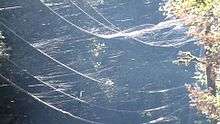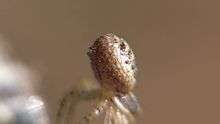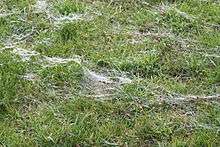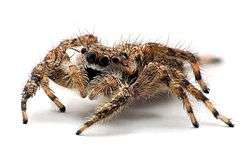Ballooning (spider)

Ballooning, sometimes called kiting, is a means by which spiders, and some other small invertebrates, can move through the air by releasing one or more gossamer threads to catch the wind. By this means they are wafted aloft and are at the mercy of the air currents. This procedure is mostly used by spiderlings to disperse, but larger individuals have been observed using it. The spider climbs to a high point, stands on its toes and points its abdomen to the sky, releasing fine silk threads from its spinnerettes until lift off occurs. Journeys achieved vary from a few metres to hundreds of kilometres. Even atmospheric data have collected samples of balloons at five kilometres above the earth and ships in mid-ocean have reported spider landings. Mortality is high.
Description

Ballooning is a behaviour in which spiders and some other invertebrates use air-borne dispersal to move between locations.[1][2] A spider (usually limited to individuals of a small species), or spiderling after hatching,[3] will climb as high as it can, stand on raised legs with its abdomen pointed upwards ("tiptoeing"),[4] and then release several silk threads from its spinnerets into the air. These automatically form a triangular shaped parachute[5] which carries the spider away on updrafts of winds where even the slightest of breezes will disperse the arachnid.[4][5] The Earth's static electric field may also provide lift in windless conditions.[6]
Many spiders use especially fine silk, called "gossamer"[7] to lift themselves off a surface, and silk also may be used by a windblown spider to anchor itself to stop its journey.[5] The term "gossamer" is used metaphorically for any exceedingly fine thread or fabric. Biologists also apply the term "balloon silk" to the threads that mechanically lift and drag systems.
It is generally thought that most spiders heavier than 1 mg are unlikely to use ballooning.[8] Because many individuals die during ballooning, it is less likely that adults will balloon compared to spiderlings. However, adult females of several social Stegodyphus species (S. dumicola and S. mimosarum) weighing more than 100 mg and with a body size of up to 14 millimetres (0.55 in) have been observed ballooning using rising thermals on hot days without wind. These spiders use tens to hundreds of silk strands, which form a triangular sheet with a length and width of about 1 metre (39 in)[5]
In Australia, in 2012 and in May 2015, millions of spiders were reported to have ballooned into the air, and landing, making the ground seem like snow covered the ground with the white spiderwebs.[9]
Distance and height achieved

Most ballooning journeys end after just a few meters of travel, although depending on the spider's mass and posture,[10] a spider might be taken up into a jet stream. The trajectory further depends on the convection air currents and the drag of the silk and parachute to float and travel high up into the upper atmosphere.[11]
Many sailors have reported spiders being caught in their ship's sails, over 1,600 kilometres (990 mi)[12] from land (Heimer 1988). They have even been detected in atmospheric data balloons collecting air samples at slightly less than 5 kilometres (16,000 ft) above sea level.[13] Evidently, it is the most common way for spiders to invade isolated islands and mountaintops.[12][14] Spiderlings are known to survive without food while travelling in air currents of jet streams for 25 days or longer.[2]
Some mites and some caterpillars also use silk to disperse through the air.
Ballooning spiders can land on water and survive afloat. Their water-repellent legs keep them alive on both fresh and salt water enable them to survive waves up to 0.5 millimetres in height. In wind spiders could raise their legs or abdomens to use as sails, propelling themselves across the water's surface. The spiders drop silk to anchor themselves in place while afloat. Said spiders did not show these behaviours on land, suggesting that they are adaptations to water.[15][16][17]
See also
- Aeroplankton
- "A Noiseless Patient Spider"—poem by Walt Whitman based on spider ballooning behaviour
- Organisms at high altitude
- Spider silk
References
- ↑ Heinrichs, Ann R. (2004) "Spiders". Compass Point Books, Primary School : Nature's Friends series; Minneapolis, Minn. ISBN 9780756505905. She observes that the so called ballooning is like a kite
- 1 2 Valerio, C.E. (1977). "Population structure in the spider Achaearranea Tepidariorum (Aranae, Theridiidae)" (PDF). Journal of Arachnology. 3: 185–190. Archived from the original (PDF) on July 19, 2011. Retrieved 2009-07-18.http://web.archive.org/web/20110719210153/http://fms.holycross.edu/JoA_free/JoA_v3_n3/JoA_v3_p185.pdf
- ↑ Bond, J.E. "Systamatic and Evolution of the Californian trapdoor spider genus Aptostichus Simon (Araneae: Mygalomorphae: Euctenizidae)". Virginia Polytechnic Institute and State University. 1999. Accessed 2009-07-18.
- 1 2 Weyman, G.S. (1995). "Laboratory studies of the factors stimulating ballooning behavior by Linyphiid spiders (Araneae, Linyphiidae)" (PDF). Journal of Arachnology. 23: 75–84. Retrieved 2009-07-18.
- 1 2 3 4 Schneider, J.M.; Roos, J.; Lubin, Y.; Henschel, J.R. (October 2001). "Dispersal of Stegodyphus Dumicola (Araneae, Eresidae): They do balloon after all!" (PDF). Journal of Arachnology. 29 (1): 114–116. doi:10.1636/0161-8202(2001)029[0114:DOSDAE]2.0.CO;2. Retrieved 2009-07-18.
- ↑ Gorham, Peter (Sep 2013). "Ballooning spiders: The case for electrostatic flight". arXiv:1309.4731
 .
. - ↑ Oxford English Dictionary 2nd ed.: Gossamer, noun and adjective: fine filmy substance, consisting of cobwebs, spun by small spiders, which is seen floating in the air in calm weather, esp. in autumn, or spread over a grassy surface: occas. with a and pl., a thread or web of gossamer.
- ↑ Suter, R.B. (1999). "An aerial lottery: The physics of ballooning in a chaotic atmosphere" (PDF). Journal of Arachnology. 27: 281–293. Archived from the original (PDF) on 2006-02-11.
- ↑ Dell'Amore, Christine; 18, National Geographic PUBLISHED May. "Millions of Spiders Rain Down on Australia—Why?". National Geographic News. Retrieved 2015-05-19.
- ↑ Suter, R.B. (1992). "Ballooning: Data from spiders in freefall indicate the importance of posture" (PDF). Journal of Arachnology. XX: 107–113. Retrieved 2009-07-18.
- ↑ Greenstone, M.H.; Morgan, C.E.; Hultsh, A.-L. (1987). "Ballooning spiders in Missouri, USA, and New South Wales, Australia: Family and mass distributions" (PDF). Journal of Arachnology. 15: 163–170. Retrieved 2009-07-18.
- 1 2 Hormiga, G. (2002). "Orsonwells, a new genus of giant linyphild spiders (Araneae) from the Hawaiian Islands" (PDF). Invertebrate Systematics. 16 (3): 369–448. doi:10.1071/IT01026. Retrieved 2009-07-18.
- ↑ VanDyk, J.K. (2002–2009). "Entomology 201 - Introduction to insects". Department of Entomology, Iowa State University. Archived from the original on 8 June 2009. Retrieved 18 July 2009.
- ↑ Bilsing, S.W. (May 1920). "Quantitative studies in the food of spiders" (PDF). The Ohio Journal of Science. 20 (7): 215–260. Retrieved 2009-07-18.
- ↑ Hayashi, Morito; Bakkali, Mohammed; Hyde, Alexander; Goodacre, Sara L. (2015-07-03). "Sail or sink: novel behavioural adaptations on water in aerially dispersing species". BMC Evolutionary Biology. 15 (1): 118. doi:10.1186/s12862-015-0402-5. ISSN 1471-2148. PMID 26138616.
- ↑ Cressey, Daniel. "Airborne Spiders Can Sail on Seas". Nature. Retrieved 2015-07-08.
- ↑ "Flying spiders also sail on water". Nature. Retrieved 2015-07-09.
Further reading
- Dean, D.A. & Sterling, W.L. (1985): Size of ballooning spiders at two locations in eastern Texas. J. Arachnol. 13: 111–120. PDF
- Heimer, S. (1988): Wunderbare Welt der Spinnen. Urania-Verlag Leipzig. ISBN 3-332-00210-4.

